Climate Change Explained
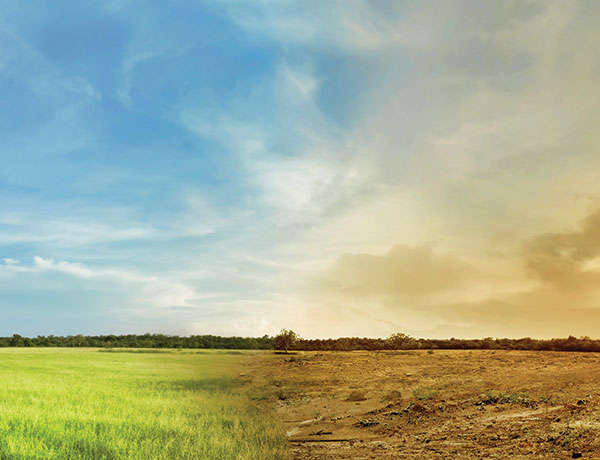
For decades, the existence of climate change has been discussed, debated, debunked, and documented. But what is climate change? What evidence do we have that it exists? How and why does it occur? Do human actions contribute to climate change? If so, what can human beings do to reverse or halt it? And what are the consequences for Earth – and for us – if it isn’t stopped?
To learn the answers to these and other climate-change questions, we reached out to two experts in the field: alumnus Jeffrey Kiehl, Ph.D.’81, who recently retired after 30 years of service as a senior scientist with the National Center for Atmospheric Research (NCAR), and Professor of Environmental Health Shao Lin, a faculty member at UAlbany’s School of Public Health.
Here, we present their findings.
As a senior scientist at the National Center for Atmospheric Research (NCAR) for three decades, Jeffrey Kiehl studied the past to predict the future. Specifically, he used information from fossils and other indicators to understand how, and why, climate change occurs.
Kiehl, who retired from NCAR in August, still serves as an adjunct professor in the Department of Earth & Planetary Sciences at UC Santa Cruz. Asked how we know that climate change occurs, he explains: “The instrumental surface record used to construct global values of temperature dates from 1850. Estimating surface temperatures further back in time is carried out through a number of methods called paleothermometry [that] consider the types of atoms found in fossils from the deep past. The difference in the number of neutrons in the nucleus of an atom leads to different ‘flavors,’ or isotopes, of carbon, oxygen, and other elements.”
Small ocean-dwelling organisms that build their shells from chemical compounds that include oxygen and carbon also contribute to our knowledge of climate change, notes Kiehl, who earned a doctorate in atmospheric sciences from UAlbany. “The ability of these organisms to use different flavors of oxygen depends on the temperature of the environment the organism inhabits. By measuring the amounts of these isotopes in fossilized shells, one can deduce the temperature of the environment where the organisms once lived.
“An independent method to measure paleo temperatures relates to the structure of lipids in ancient organisms and to the structures’ dependence on temperature. Comparison of these two independent methods to deduce temperature allows scientists to confirm the accuracy of the temperatures.”
While temperature is often the focus as the main indicator of climate change, “there are actually many other changes related to increases in temperature or indirectly related to temperature,” Kiehl says. “Observations from historical records, and more recently from satellites, clearly show an increase in global sea level. Roughly half of this increase arises because sea water warms as it expands. The other half is due to the melting of the large ice sheets in Greenland and Antarctica, which is independently observed from other satellites. Observations also indicate an increase in the intensity of storm systems and associated precipitation, which is expected in a warming world.
“Earth’s climate has followed the ups and downs of atmospheric carbon dioxide and are one way we know this gas plays a major role in our climate system,” notes Jeffrey Kiehl, recently retired after 30 years as an NCAR senior scientist.
“Satellites also measure the amount of atmospheric water vapor, which has also been increasing over the past few decades as Arctic sea ice has dramatically declined. We are now seeing record-low summer sea ice extent in the Arctic. The bloom timing of trees has been shifting to earlier dates over the past few decades. For example, the cherry blossoms bloom in Washington, D.C., much earlier now than they did just two decades ago,” Kiehl observes.
In addition, “the oceans are becoming more acidic because about a quarter of the carbon dioxide emitted into the atmosphere through the burning of fossil fuels goes into them. The warming and acidification of the oceans is leading to a precipitous decline in corals.”
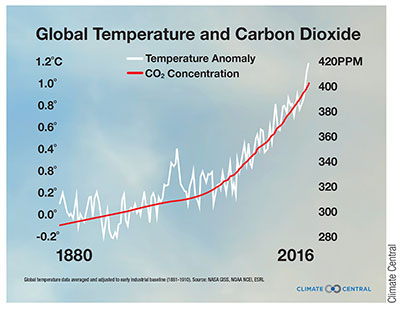
According to Kiehl, “Earth’s climate has changed throughout geologic time. Some of the most dramatic changes in Earth’s deep past, millions of years ago, are associated with slow, long-term changes in the amount of carbon dioxide in the atmosphere, while others have to do with the very slow change in the sun’s energy output.” On geologic time scales, volcanic activity determines the amount of carbon dioxide in the atmosphere, while weathering processes – such as rain’s reaction with rock surfaces – remove it. “These processes work on time scales of thousands to millions of years and thus lead to slow growth and decline of the greenhouse gas carbon dioxide. Earth’s climate has followed the ups and downs of atmospheric carbon dioxide and are one way we know this gas plays a major role in our climate system.
“The ice ages are another example of climate change driven by the orbital variations of Earth on tens of thousands to hundreds of thousands of years,” Kiehl continues. “These variations affect the amount of sunlight reaching higher latitudes, which, in turn, led to the growth and decay of large ice sheets. Again, the changes have occurred on long time scales and are driven through natural changes.”
Also impacting Earth’s climate system are the interactions, such as El Niño, between the atmosphere and the oceans. However, Kiehl adds, “these decade-long variations do not lead to a long-term trend in warming or cooling, where ‘long-term’ means centuries to thousands of years.”
Humans also play a role in climate change. “The amount of carbon dioxide injected by humans is over a thousand times larger than any natural source, and it is occurring quite rapidly, compared to any geological process.” Changes in vegetation cover and type can likewise affect the climate system.
What is causing the planet to warm now? “The overwhelming answer,” Kiehl responds, “is human activity through the burning of fossil fuels. No other mechanism, be it solar variability, changes in vegetation, or internal variations, can explain the warming over the 20th century and now, early in the 21st.”
Causes of Climate Change 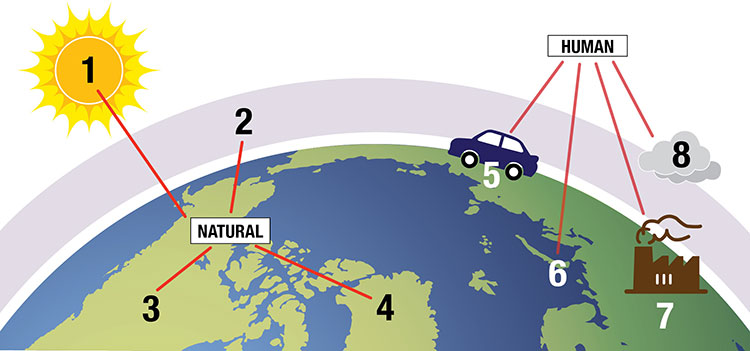
Kiehl states: “The basic science of climate change is well understood. If we continue to increase atmospheric carbon dioxide levels, the planet will continue to warm. If we stay the course by relying on fossil fuels, in 80 years we will have more than tripled atmospheric carbon-dioxide levels since the Industrial Revolution. The last time the atmosphere contained that much carbon dioxide was 40 to 50 million years ago. We know that the Earth back then was much warmer than it is today.
“We are now returning the atmosphere to this condition in less than 200 years, leading to a climate system unknown to the human species. The sooner we dramatically reduce our use of fossil fuels, the better chance we have to avoid the worst consequences of human-caused climate change. We often hear that doing something about climate change will cost too much. However, the cost to our children and all future generations will be much greater if we do nothing to address this issue.”
Extreme Weather, Extreme Consequences
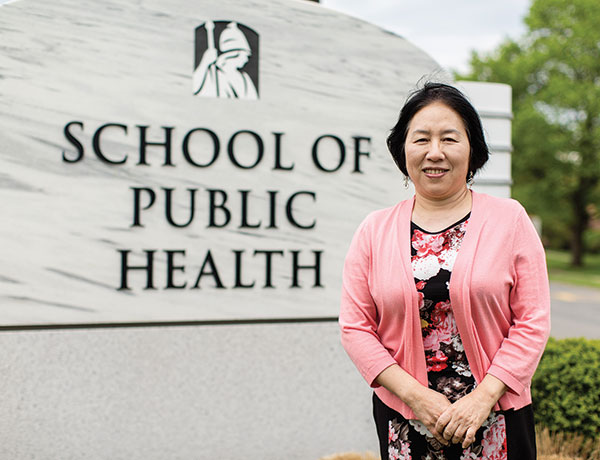
If you think that changes in weather and climate have no bearing on human life and health, Shao Lin, M.P.H., Ph.D., M.D., might convince you otherwise. A professor of environmental health at UAlbany’s School of Public Health, Lin investigates the ways that climate change and extreme weather impact human-health outcomes. And her findings reveal that those impacts may span the life cycle, affect all populations, and relate to multiple diseases.
Since joining the New York State Department of Health in 1990, Lin has worked on more than 40 environmental-health projects, including “various air-pollution projects, such as exposure to heavy traffic, air pollutants, or urban-air toxins as they relate to human health.” Fifteen years ago, her research focus broadened when she “found more and more extreme-weather events, such as the 2003 European heat wave and the Northeast blackout. I realized that extreme climate-change-related weather events could impact human health, which would be an important and otherwise forgotten area for research,” explains Lin, who earned her medical degree at Sun Yat-Sen University in her native China and completed master’s and doctoral studies at the University of North Carolina-Chapel Hill.
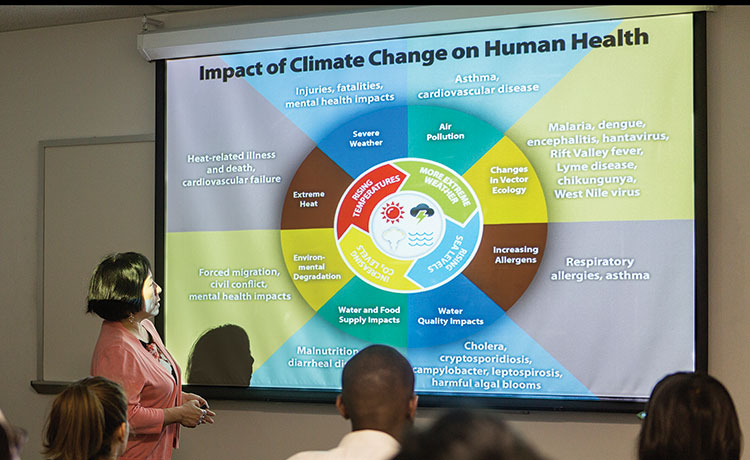
At the invitation of Congress, Lin has consulted on several expert panels working to determine the direction research on climate change and children’s health should take. She adds: “We are one of the teams conducting the earliest climate-change/health studies in the U.S. We have found many health outcomes are associated with extreme weather and disaster events, demonstrating that climate and health are important environmental areas where I can dedicate my research efforts.”
Lin and her research team have found that increased or extreme temperature, humidity, and precipitation can:
- exacerbate respiratory conditions, such as allergies, asthma, and Chronic Obstructive Pulmonary Disease (COPD), and cardiovascular diseases;
- contribute to various renal diseases;
- be associated with adverse birth outcomes, such as birth defects; and may
- promote the propagation of deer ticks, which cause Lyme disease, and the spread of other vector-borne illnesses.
Mental-health issues also arise from extreme weather events, Lin contends. Superstorm Sandy, and the flooding, fires, and power failures that ensued, ravaged the New York City area in 2012. Together, the events occasioned 200 emergency-room visits – “approximately four times the usual number” – for substance abuse, Lin discovered while studying New York State Department of Health data tracking hospital discharges and emergency-department visits for that period. In addition, the hurricane precipitated anxiety, mood disorders, and other mental-health issues that “lasted anywhere from three months to as long as one year after the disaster,” the professor wrote in the October 2017 edition of The Conversation.
Interviewed by The New York Times Magazine, Lin predicted similar effects on mental health in Puerto Rico, devastated in September 2017 by Hurricane Maria. The Times cited her 2016 study on the impact of Hurricane Sandy, which “found that impacted areas of New York experienced extended blackouts and disruptions to public transportation and health care. The impact on mental health was substantial, she concluded; there was a significant increase in emergency room visits for substance abuse problems, psychosis, mood disorders and suicides throughout the city.” Puerto Rico has continued to experience intermittent but long-term power outages resulting from Maria, and the official total number of deaths originally ascribed to the hurricane was 64.
In August, however, the Puerto Rican government raised the total number of dead to more than 1,400, and authorities acknowledge that the death toll may actually be closer to 3,000.
Through her research, Lin seeks to determine whether populations with certain sociodemographic characteristics may be most affected by a particular event. Her investigation of the August 2003 Northeast blackout revealed that women and the elderly were particularly at risk for higher-than-normal hospital admissions for respiratory ailments. One group for which hospitalizations did not spike expectedly as during heat events was the lower-income population – less likely than others to have air-conditioning and therefore more accustomed to extreme heat, explains Lin.
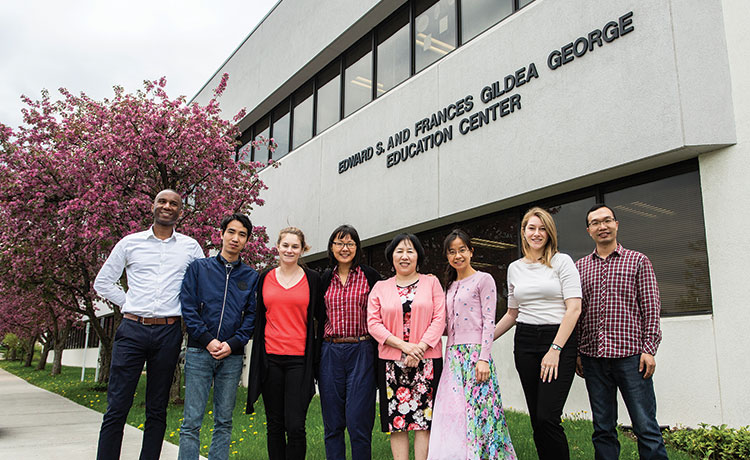
By extension, Lin’s research serves another valuable purpose: enabling civil authorities or state agencies to amass and distribute supplies, such as food and medical aid, that will be most in demand in the wake of a hurricane or another catastrophic event. Preparedness is key, Lin notes, to maximizing response times and minimizing loss of life. In Time.com’s Oct. 4, 2017 article “How Power Outages Can Affect Mental Health,” Lin commented, “New York City prepared well for Sandy.”
Lin conducts research with collaborators all over the world, including in China, where she investigated whether humidity modifies the relationship between temperature and cardiovascular mortality, and in Romania, where she has studied indoor air quality and classroom comfort in schools. Her work has been supported by the National Institutes of Health, the Environmental Protection Agency, the Centers for Disease Control and Prevention, and other prestigious organizations.
At UAlbany, Lin’s course offerings include Global Climate Change, Extreme Weather, and Public Health Applied Epidemiology and Protocol Development and Grant Writing.